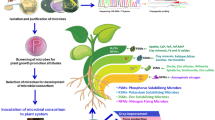Abstract
The effect of thiamine limitation in combination with fungal elicitation on sesquiterpene (solavetivone) production was studied in Agrobacterium-transformed “hairy-root” cultures of Hyoscyamus muticus as a potential means of manipulating the growth rate independent of phosphorus availability. Limiting the initial supply of thiamine did not affect the growth of these cultures compared to growth at the control level of thiamine (0.01 g/l). There was also no enhancement in sesquiterpene production when thiamine supply was limited. Serial culturing in thiamine-free media suggests that these root cultures are not strictly auxotrophic for thiamine, in contrast to previously published results for untransformed root culture. The effect of phosphate limitation combined with elicitation on the production of solavetivone was examined at constant media volume to provide a constant elicitor concentration and to eliminate feedback-inhibition effects. Limiting the initial supply of phosphate to elicited cultures resulted in a twofold increase in solavetivone production as compared to the elicitation at control media phosphate levels (1.1mm). Because growth was attenuated, production per unit cell mass increased 11-fold compared to the control. The effect of phosphate limitation on solavetivone production at constant cell mass and elicitor per root mass was studied. Limiting the initial supply of phosphate to elicited cultures under these conditions did not result in enhanced production of solavetivone. The initially observed enhanced production of solavetivone at limiting initial phosphate concentrations is therefore due to factors other than the growth rate or phosphate involvement in secondary metabolism.
Similar content being viewed by others
References
Bonner J (1937) Vitamin B1: a growth factor for higher plants. Science 85:183–184
Chappell J, Nable R (1987) Induction of sesquiterpeneoid biosynthesis in tobacco cell suspension cultures by fungal elicitor. Plant Physiol 85:469–473
Curtis WR, Hasegawa PM, Emery AH (1991) Modeling linear and variable growth in phosphate limited suspension cultures of opium poppy. Biotechnol Bioeng 38:371–379
Dische Z (1961) General color reactions. Methods Carbohydr Chem 1:478–512
Dougall DK, LaBrake S, Whitten GH (1983) The effects of limiting nutrients, dilution rate, culture pH, and temperature of the yield constant and anthocyanin accumulation of carrot cells grown in semicontinuous chemostat culture. Biotechnol Bioeng 25:569
Dunlop DS, Curtis WR (1991) Synergistic response of plant hairy root cultures to phosphate limitation and fungal elicitation. Biotechnol Prog 7:434–438
Flores HE, Curtis WR (1992) Approaches to understanding and manipulating the biosynthetic potential of plant roots. In: Pederson H, Mutharson R, Di Biasio D (eds) Biochemical Engineering VII: Cellular and reaction engineering. Proceedings of the New York Academy of Science, New York, p 188
Flores HE, Hoy M, Pickard J (1987) Secondary metabolites from root cultures. Trends Biotechnol 5:64–69
Gamborg OL, Miller RA, Ojima K (1968) Nutrient requirements of suspension cultures of soybean root cells. Exp Cell Res 50:151–158
Julliard J-H, Douce R (1991) Biosynthesis of the thiazole moiety of thiamine (vitamin B1) in higher plant chloroplasts. Proc Natl Acad Sci US 88:2042–2045
Knobloch K, Berlin J (1983) Influence of phosphate on the formation of the indole alkaloids and phenolic compounds in cell cultures of Catharanthus roseus I. Comparison of enzyme activities and product accumulation. Plant Cell Tissue Organ Cult 2:333–340
Krampitz LO (1970) Thiamin published with the accepted but less common spelling of thiamine diphosphate and its catalytic functions. Dekker, New York
Mantell SH, Pearson DW, Hazell LP, Smith H (1983) The effect of initial phosphate and sucrose levels on nicotine accumulation in batch suspension cultures of Nicotiana tabacum L. Plant Cell Rep 2:73
Schiel O, Jarchow-Redecker K, Piehl G, Lehmann J, Berlin J (1984) Increased formation of cinnamoyl putrescines by fedbatch fermentation of cell suspension cultures of Nicotiana tabacum. Plant Cell Rep 3:18–20
Signs M, Flores HE (1989) Elicitation of sesquiterpene phytoalexin biosynthesis in transformed root cultures of Hyoscyamus muticus. Plant Physiology Suppl 4:135
Street HE, Jones OP (1961) Nutritional problems raised by work with root cultures. In: Maheshwari P, Ranga Swamy NS (eds) Plant tissue and organ culture. International Society of Plant Morphologists, Delhi, India, p 58
White PR (1937) Vitamin B1 in the nutrition of excised tomato roots. Plant Physiol 12:803–811
Author information
Authors and Affiliations
Additional information
Correspondence to: W. R. Curtis
Rights and permissions
About this article
Cite this article
Pannuri, S., Reddy, G.R., McNeill, D. et al. Interpreting the role of phosphorus and growth rate in enhanced fungal induction of sesquiterpenes from Hyoscyamus muticus root cultures. Appl Microbiol Biotechnol 38, 550–555 (1993). https://doi.org/10.1007/BF00242953
Received:
Accepted:
Issue Date:
DOI: https://doi.org/10.1007/BF00242953




